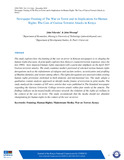| dc.contributor.author | Ndavula, John O. | |
| dc.contributor.author | Mwangi, J. | |
| dc.date.accessioned | 2023-02-10T14:33:36Z | |
| dc.date.available | 2023-02-10T14:33:36Z | |
| dc.date.issued | 2022-07 | |
| dc.identifier.citation | Journal of the Kenya National Commission for UNESCO, Vol. 2 (1) July -December 2022 | en_US |
| dc.identifier.uri | http://hdl.handle.net/123456789/6168 | |
| dc.description.abstract | The study explores how the framing of the war on terror in Kenyan newspapers is re-shaping the human rights discourse. It principally explores how Kenya's counterterrorism responses since the late 1990s have impacted human rights enjoyment with a particular emphasis on the April 2015 Garissa terrorist attacks. The study examines media's portrayal of selected various human rights derogations such as the refoulement of refugees and asylum seekers, securitization and profiling of Muslim identities, and torture among others. The rights derogations are assessed within existing human rights provisions enshrined in both domestic and international law. The study adopts a qualitative content analysisapproach to identify media frames of terrorism in print media. The study analyzed the contents of 105 news articles that were published in The Standard newspaper regarding the Garissa University College terrorist attack within four weeks of the attacks. The findings indicate an increased media tolerance towards the violation of the rights of civilians in the context of the war on terror. The study recommends that the media should not abandon championing for human rights in the context of the war on terror. | en_US |
| dc.language.iso | en | en_US |
| dc.subject | Framing; Human Rights; Mainstream Media; War on Terror; Kenya | en_US |
| dc.title | Newspaper Framing of The War on Terror and its Implications for Human Rights: The Case of Garissa Terrorist Attacks in Kenya | en_US |
| dc.type | Article | en_US |

